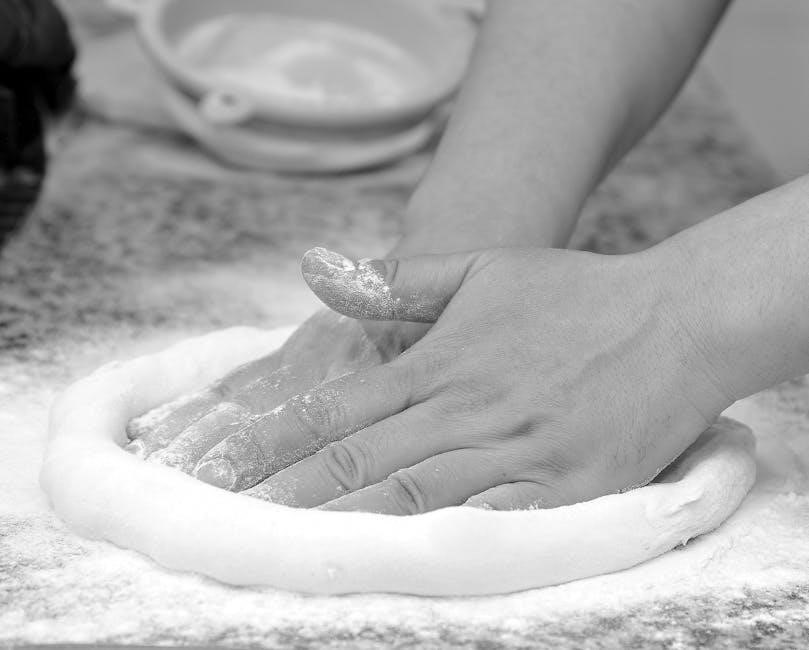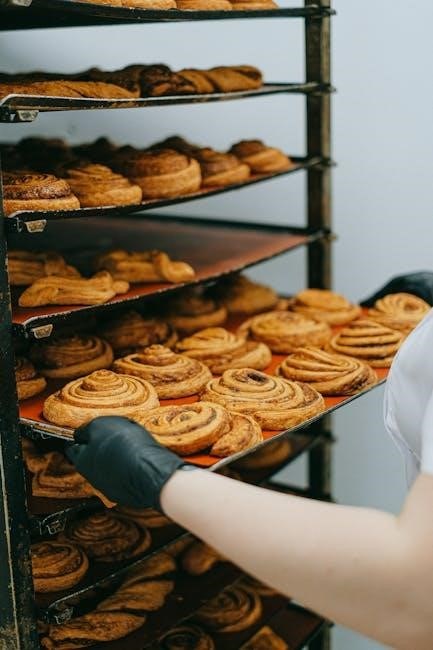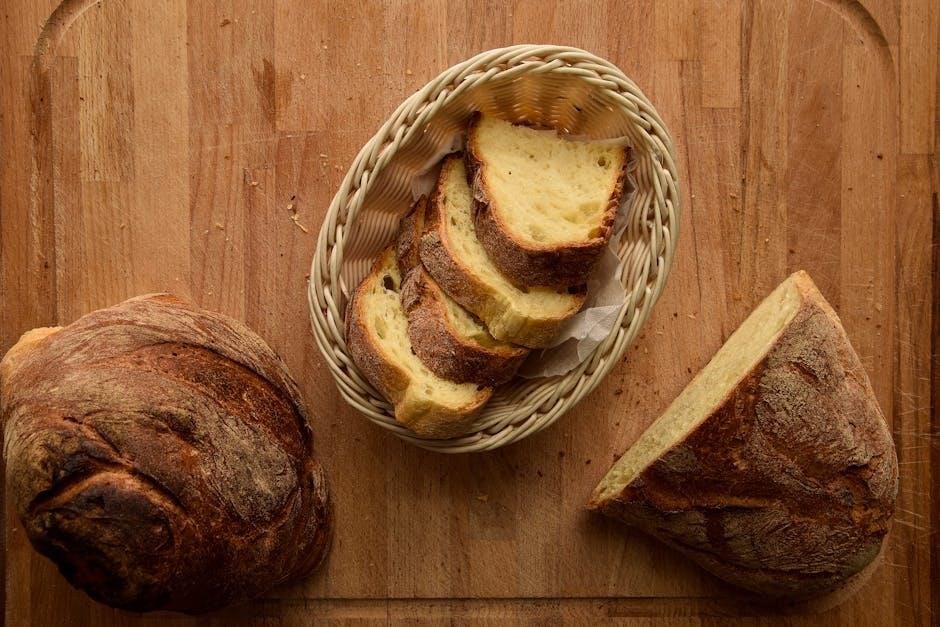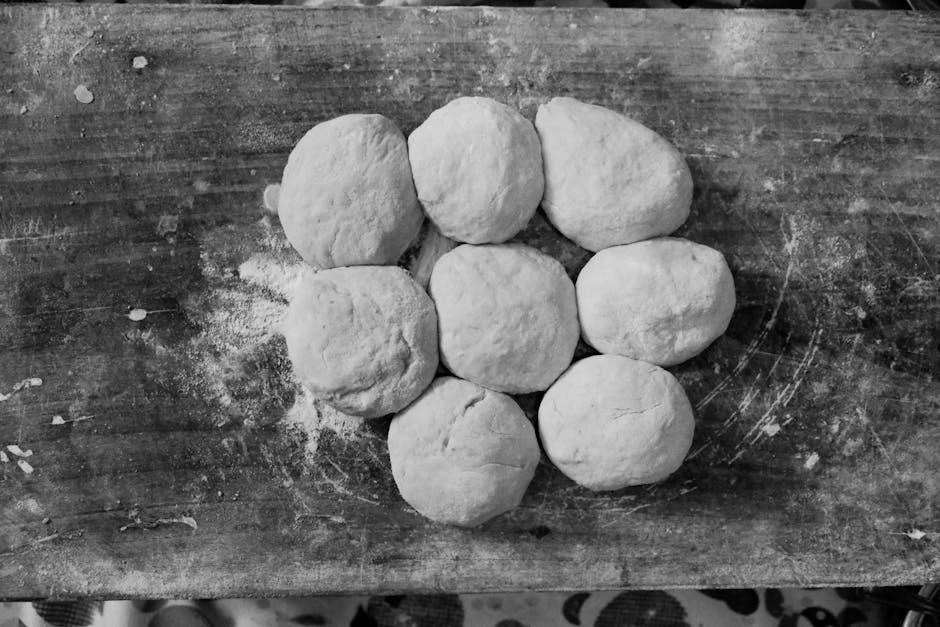Black and Decker Bread Maker Recipe Book PDF: A Comprehensive Guide
Unlock a world of homemade bread possibilities with the Black and Decker Bread Maker Recipe Book, conveniently available in PDF format․ This comprehensive guide offers a variety of recipes, from basic loaves to specialty creations․
Black and Decker bread makers have gained popularity for their convenience and ability to produce fresh, homemade bread with minimal effort․ These machines automate the bread-making process, from kneading and rising to baking, allowing users to enjoy delicious bread without extensive hands-on involvement․

Designed with user-friendliness in mind, Black and Decker bread makers typically feature intuitive controls and pre-programmed settings for various types of bread, doughs, and even cakes․ This versatility makes them suitable for both novice and experienced bakers․ Many models include a non-stick bread pan and kneading paddle for easy cleanup, and some offer additional features like a fruit and nut dispenser or a delay timer for baking bread at a later time․
Furthermore, Black and Decker bread makers are often accompanied by a recipe book, providing users with a starting point for exploring different bread recipes and experimenting with flavors․ These recipe books are a valuable resource for maximizing the potential of the bread maker and creating a wide range of baked goods․
Availability of Recipe Books in PDF Format
The convenience of digital resources has extended to the realm of bread making, with Black and Decker recipe books increasingly available in PDF format․ This digital accessibility offers several advantages for bread maker enthusiasts․ Firstly, PDFs are easily downloadable and accessible on various devices, including computers, tablets, and smartphones, allowing users to access recipes from anywhere in the kitchen or on the go․
Secondly, PDF format enables users to search for specific recipes or ingredients within the document, making it easier to find the desired recipe quickly․ Additionally, PDFs can be easily shared with friends and family, fostering a community of bread-making enthusiasts․
Several sources offer Black and Decker bread maker recipe books in PDF format, including the official Black and Decker website, third-party recipe websites, and online forums․ These digital recipe books often contain a wide range of recipes, catering to different tastes and dietary preferences․ The availability of these resources in PDF format ensures that users can easily access and utilize the recipes to create delicious homemade bread․

Finding the Right Black and Decker Bread Maker Recipe Book
Discovering the perfect Black and Decker bread maker recipe book involves exploring various avenues․ Online searches, the official website, and third-party recipe sites provide resources for bread-making enthusiasts․
Online Search for Recipe Books
Embarking on an online search for Black and Decker bread maker recipe books in PDF format can be a fruitful endeavor․ Utilize search engines like Google, Bing, or DuckDuckGo with specific keywords such as “Black and Decker bread maker recipe book PDF” or “bread machine recipes PDF․”
Refine your search by including the model number of your bread maker for more targeted results․ Explore websites that specialize in appliance manuals and recipe collections․ Be cautious of downloading files from unverified sources to avoid potential security risks․
Look for reputable websites and forums dedicated to bread making, as these often host user-contributed recipes and resources․ Remember to always scan downloaded files with an antivirus program before opening them․ With careful searching, you can find a treasure trove of recipes online․
Black and Decker Official Website
The Black and Decker official website is a prime resource for locating recipe books specifically designed for their bread makers․ Navigate to the “Support” or “Manuals” section of the website and search for your bread maker model number․
Often, the product page for your model will include a downloadable PDF version of the original recipe book that came with the appliance․ This is the safest and most reliable source for accurate recipes and instructions tailored to your specific bread maker․
In addition to recipe books, the official website may also offer troubleshooting guides, FAQs, and other helpful resources for using your Black and Decker bread maker․ Regularly checking the website can provide updates and new recipe ideas to enhance your bread-making experience and ensure optimal performance of your appliance․
Third-Party Recipe Websites
Beyond the official Black and Decker resources, numerous third-party recipe websites cater to bread machine enthusiasts․ These platforms often host a vast collection of bread recipes specifically adapted for various bread maker models, including Black and Decker․
Websites dedicated to cooking and baking frequently feature user-submitted recipes and reviews, offering a diverse range of options and perspectives․ When using third-party websites, it’s crucial to exercise caution and verify the accuracy of the recipes before attempting them․
Look for recipes with positive reviews and ratings from other users, and always double-check the ingredient measurements and instructions․ Some websites may also offer forums or comment sections where you can ask questions and seek advice from experienced bread machine users․ Remember that recipes may need slight adjustments to suit your specific Black and Decker model․

Types of Recipes Included in Black and Decker Bread Maker Recipe Books
Black and Decker recipe books offer diverse bread recipes, from basic white and wheat to specialty options like sourdough, sweet breads, and even dough recipes for pizza and rolls․
Basic Bread Recipes
The foundation of any good bread maker recipe book lies in its collection of basic bread recipes․ These are the tried-and-true formulas that serve as the starting point for countless variations and more complex creations․ Within the Black and Decker Bread Maker Recipe Book, you’ll find recipes for classic white bread, whole wheat bread, and other simple loaves․ These recipes typically involve readily available ingredients like flour, water, yeast, salt, and perhaps a touch of sweetener or oil․
These basic recipes are designed to be foolproof and easy to follow, making them perfect for beginners who are just starting their bread-making journey․ They often include clear instructions on measuring ingredients accurately, adding them in the correct order, and selecting the appropriate settings on your Black and Decker bread maker model․ Mastering these basic recipes will give you the confidence and skills to experiment with more advanced bread-making techniques and recipes in the future․ Expect clear instructions and readily available ingredients․
Specialty Bread Recipes
Beyond the basics, the Black and Decker Bread Maker Recipe Book truly shines with its array of specialty bread recipes․ These recipes cater to a more adventurous palate, offering a diverse range of flavors and textures․ Expect to find options like French bread, sourdough, rye bread, and even sweet breads like cinnamon raisin or banana bread․ These recipes often incorporate additional ingredients such as herbs, spices, nuts, seeds, or dried fruits to elevate the taste and aroma of the final product․
Specialty bread recipes provide an opportunity to explore the full potential of your Black and Decker bread maker․ They may require slightly more advanced techniques or specific ingredients, but the results are well worth the effort․ Some recipes might even involve pre-ferments or longer rising times to develop a richer, more complex flavor profile․ Whether you’re craving a savory loaf for sandwiches or a sweet treat to enjoy with coffee, the specialty bread section has something for everyone․ Each recipe is crafted to deliver outstanding taste and texture when prepared in your bread maker․
Dough Recipes for Other Baked Goods
A fantastic feature of the Black and Decker Bread Maker Recipe Book is its inclusion of dough recipes specifically designed for other baked goods․ Your bread maker isn’t just for bread; it can be a valuable tool for preparing dough for pizza, rolls, pastries, and even pasta․ These dough recipes simplify the process by automating the kneading and rising stages, saving you time and effort in the kitchen․
Imagine effortlessly creating pizza dough, ready to be topped with your favorite ingredients, or crafting soft, fluffy dinner rolls for a special occasion․ The recipe book provides clear instructions for each dough type, ensuring consistent results every time․ These recipes typically involve using the dough cycle on your bread maker, which gently mixes and kneads the ingredients before allowing the dough to rise in a controlled environment․ Once the dough is ready, you can shape it according to your desired baked good and bake it in a conventional oven․ This versatility makes the Black and Decker bread maker a truly multi-functional appliance․

Tips for Using Black and Decker Bread Maker Recipes
Achieving baking success with your Black and Decker bread maker involves a few key tips․ These simple practices will ensure your loaves are perfectly baked every time․
Measuring Ingredients Accurately

Accurate measurement is paramount for consistent results with any Black and Decker bread maker recipe․ The delicate balance of ingredients dictates the bread’s texture, rise, and overall quality․ Using the correct measuring tools and techniques is key to success․
For dry ingredients like flour and sugar, use dry measuring cups and level off excess with a straight edge․ Avoid scooping directly from the container, as this can compress the ingredients and lead to over-measurement․ Spoon the ingredient into the cup and then level it off․ Liquid ingredients should be measured in liquid measuring cups, placing the cup on a flat surface and reading the measurement at eye level․
Pay close attention to the units of measurement specified in the recipe, whether it’s cups, tablespoons, or grams․ Using a kitchen scale for more precise measurements, especially for yeast and salt, is highly recommended․ Consistent and accurate measurements pave the way for perfectly baked bread every single time․
Adding Ingredients in the Correct Order
Following the specified order of ingredients is crucial when using a Black and Decker bread maker․ The sequence in which ingredients are added affects the mixing process and the ultimate quality of your bread․ Typically, recipes instruct you to add liquids first, followed by dry ingredients, and finally, yeast․
Adding liquids first helps to prevent the dry ingredients from clumping and ensures that the yeast doesn’t come into direct contact with the liquids too early․ This prevents premature activation of the yeast, which can lead to inconsistent rising․ The dry ingredients, such as flour and sugar, are then layered on top of the liquids․
Yeast is usually added last, often in a well created in the center of the dry ingredients․ This prevents the yeast from activating prematurely and ensures that it is evenly distributed during the kneading process․ Always refer to your specific recipe for the recommended order, as variations may occur․ Adhering to the correct order guarantees optimal mixing and a successful baking outcome․
Adjusting Recipes for Different Models
Black and Decker bread makers come in various models, each with its own unique capacity and settings․ Therefore, it’s essential to adjust recipes to suit your specific bread maker model for optimal results․ Start by consulting your bread maker’s manual to understand its capacity and recommended settings․
If a recipe is designed for a larger loaf size than your machine can handle, reduce the ingredient quantities proportionally․ Conversely, if the recipe is for a smaller loaf, you may need to increase the quantities, but be cautious not to exceed your bread maker’s maximum capacity․
Pay close attention to the cycle settings․ Different models may have variations in cycle durations and temperature profiles․ Experiment with different settings to find what works best for each recipe․ Keep detailed notes of your adjustments to refine your recipes over time․ Remember, a successful loaf depends on tailoring the recipe to your bread maker’s specific capabilities․

Troubleshooting Common Bread Maker Issues
Even with the best recipes, bread maker issues can arise․ Understanding common problems and their solutions will help you achieve perfect loaves every time․ Let’s explore some troubleshooting tips․
Bread Not Rising
A common frustration with bread makers is when the bread fails to rise adequately․ Several factors can contribute to this issue, hindering the final product․ Expired or inactive yeast is a primary suspect, as it’s essential for fermentation․ Always check the yeast’s expiration date and perform a proofing test before use․

Incorrect ingredient measurements can also impact rising․ Precise measurements, particularly of yeast, flour, and liquids, are crucial for proper dough development․ Overly dense dough, often resulting from too much flour, can inhibit rising․ Additionally, ensure the bread maker is placed in a warm environment, as cold temperatures can slow down or prevent yeast activity․
Another potential cause is adding ingredients in the wrong order․ Typically, liquids should go in first, followed by dry ingredients, with yeast last, to prevent premature activation․
Crust Too Dark or Too Light
Achieving the perfect crust color is a balancing act, and bread makers can sometimes present challenges․ A crust that’s too dark often indicates excessive sugar content in the recipe․ Reducing the amount of sugar or sweeteners can help prevent over-browning․ Conversely, a crust that’s too light may result from insufficient sugar or a lack of browning agents like milk or eggs․
Another factor is the bread maker’s settings․ Selecting the wrong crust color setting can lead to undesirable results․ Ensure the appropriate setting is chosen based on the bread type and desired crust color․ Furthermore, high humidity levels can affect crust development, leading to a softer, lighter crust․ Experimenting with slightly reducing the liquid content in the recipe can counteract this effect․

Finally, some bread maker models have a tendency to bake hotter than others․ Monitoring the bread during the baking cycle and adjusting the time accordingly can help achieve the desired crust color․
Bread Collapsing After Baking
A collapsed loaf can be disheartening, but understanding the causes can help prevent future mishaps․ Over-proofing is a common culprit, occurring when the dough rises for too long, weakening the gluten structure․ Reduce the proofing time, especially in warm environments, to maintain dough integrity․ Conversely, insufficient gluten development can also lead to collapse․ Ensure adequate kneading time to strengthen the gluten network․

Another contributing factor is excessive liquid in the recipe․ Too much liquid weakens the dough, making it unable to support its own weight during baking․ Carefully measure ingredients, particularly liquids, and adjust as needed based on environmental conditions․
In addition, using old or inactive yeast can hinder proper rising and lead to a collapsed loaf․ Always check the yeast’s expiration date and perform a proofing test before use․ High altitude baking often requires adjustments to prevent collapse․ Reducing yeast and increasing liquid can help maintain loaf structure at higher elevations․ Also make sure that the lid of your bread maker isn’t opened mid-cycle․
